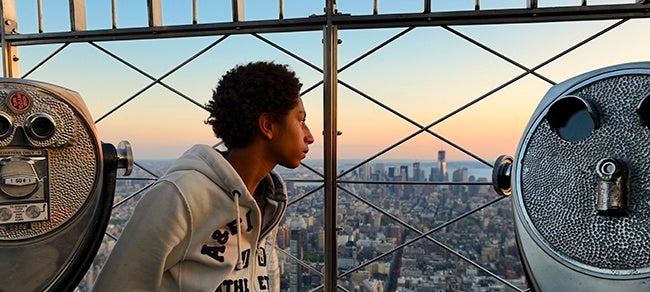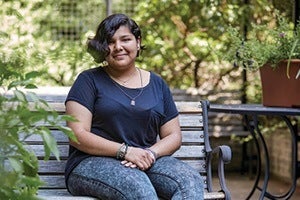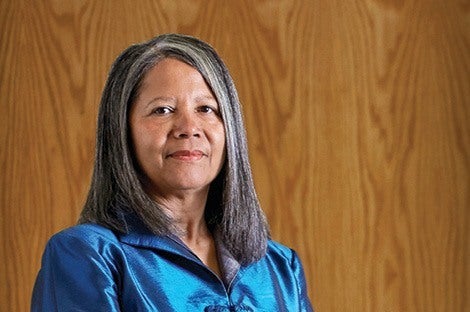[ Fall 2014 ]
HSPH alumna’s immigrant journey inspires career transforming teens’ health.
Angela Diaz, MPH ’02, knows what it’s like to overcome nearly impossible odds—and to pay forward the hard lessons she learned along the way. She spent her childhood in extreme poverty in the Dominican Republic, where her single mother worked punishing hours in a hotel laundry room to support her and her siblings. Diaz also survived two serious childhood accidents. In one, boiling water spilled on her; in the other, Diaz tripped on a glass jar, lacerating her stomach and leading to a long hospital recovery. “That’s when I first decided I wanted to be a doctor,” she says. Her next trauma came at age 8, when her mother left the country to find a better life in America. Diaz stayed unhappily behind with her father’s second family. At 12, she rejoined her mother in the Bronx, New York, where she overstayed her visa and spent a year terrified that she would be deported. Eventually, she got her papers in order and—after a year back in the Dominican Republic—started high school in New York City. She rarely saw her mother, who spent most of her time working at a garment factory. Diaz had to take on three jobs herself—at a beauty salon, at a luncheonette, and as a tutor.
Despite these setbacks, she worked hard at high school, piling on the math and science classes, keeping up her grades. Eventually, though, the accumulated stress caught up to her. “By 12th grade, I couldn’t hold it together. I just stopped going to school,” she says. “I was obviously depressed. I wouldn’t leave the house.”
But then Diaz made one of the most fateful decisions of her life: She showed up at the doors of the Mount Sinai Adolescent Health Center.
Sanctuary in the city
It was the early 1970s, shortly after the center, located in the lower part of Harlem in New York City, opened as one of the first clinics dedicated to the physical, mental, and even practical needs of teenagers.
Diaz first met with a mental health counselor, who talked her through her depression. The staff then got in touch with her high school, where her teachers wanted Diaz back. Encouraged by her newfound support team, Diaz returned to her studies and graduated.
Her social worker pushed her to go on in her education, and she soon enrolled in City College, three blocks from home. One day, before she’d even graduated, Diaz stopped in at Columbia University’s College of Physicians and Surgeons—also in her neighborhood—and picked up an application. She’d never given up her dream of becoming a doctor, so she met with an admissions officer and made the case that even though she hadn’t taken the standard medical school exams and didn’t have the $15 application fee, she could handle the work.
Within months, still without an undergraduate degree, Diaz was accepted into the class of 1981. At first, she had planned to become a neurosurgeon. But after a rotation in pediatrics and, later, a residency at the Mount Sinai center, her gift for working with troubled teenagers became clear. In 1989, she accepted an offer to run the center.
Now 59, Diaz has built one of the country’s largest and most respected programs for adolescent care, based on an integrated approach that gives equal weight to physical health, mental well-being, and social welfare. The center treats more than 11,000 youths every year— and thanks to Diaz’s initiatives, the cost of care has shifted from sliding scale to free, and the age range now extends to 24. The center has also grown into a premier research and training institution.
“I had not thought about adolescent medicine as a career,” says Diaz. “But once I worked with these kids, I fell in love with them. I know who they are. This is the person I was—the person that, in many ways, I still am.”
From depression to HIV to relationship violence
The teens may come in for a cough or cold, but that’s just a jumping-off point. “If we just ask them, ‘Do you have a headache? Do you have a fever?,’ that’s all we are going to get back,” Diaz explains. “But we ask them, ‘How do you feel? Has anyone ever touched your body when you didn’t want them to? Do you feel sad or depressed? What’s in your soul? Why are you really here? How can we help you?’”
That’s how providers learn what adolescents are grappling with—from depression to HIV to relationship violence. And Diaz tells her staff not to dance around the details. “We ask them very specifically, ‘Are you having sex?’ And we will say ‘penis,’ ‘vagina,’ ‘anus,’ ‘oral sex.’ Because otherwise, they will not tell you and you will not be able to help, because you won’t know what they are really involved with.”
Bridging sexuality gap for teens’ families
A large percentage of the center’s patients are gay or lesbian, and worry that the news won’t go down well with their families. “One of the first things that we ask is, ‘How do you get along with your parents? Do you tell them everything?’” Diaz says. “They may say, ‘Oh no, they would kill me.’” So while the center guarantees complete confidentiality, the staff offers to act as a bridge within families, especially in the case of gay or sexually active teens. “Bring your parents here,” says Diaz. “We will sit down with you and your parents and help you tell them. And we will not let you go home if we think you’re in danger.”
The center has also become a well-known resource for teenagers who feel they are living as the wrong gender. “We help them transition, even physically,” Diaz says. “We give them the hormones, we give them the emotional support, and they evolve. And we work with the parents, because sometimes it’s hard for parents to accept or understand.”

Without the center, Diaz says, many adolescents would likely cope with their problems in more destructive ways—substance abuse, violent behavior, joining gangs. That’s why it so important to reach them at this critical juncture in their lives, when many behaviors and patterns become established.
She also creates policies and programs that take into account the unpredictable nature of adolescence. Unlike some health centers, which blacklist patients for missing appointments, Diaz doesn’t care how many dates her young clients blow off, how many doses of medication they forgot to take, or what sort of trouble they’ve gotten into with the law. “If they come back for the seventh time with the same thing that we have been trying to help them with,” she says, “we still receive them open-handed and open-armed.”
In keeping with teen culture, the center offers a 24-hour texting service, called Text in the City, so young people can ask on-call doctors questions any time of day or night—say, what to do if they had unprotected sex, or what to give their baby for a fever. Preoccupied teens can even get daily texts when it’s time to take their HIV medication or birth control pills, or to come in for a vaccine or a routine checkup. They are even texted reminders to exercise regularly and to eat fruits and vegetables.
Acquiring a research focus at HSPH
After years of getting to know her patients’ stories, Diaz thought there must be a way to tie them all together and improve her center’s programs. “I was always interested in population health,” she says, “and how you change systems so that individuals can make better health choices.”
In particular, Diaz wanted to understand trends in adolescent health. What’s the rate of HIV infection? How many low-income teens have been sexually abused and what kinds of services help them? Which programs succeed at getting kids off drugs or keeping them in school? How effective is the HPV vaccine if, as is common with teens, it is not taken on schedule?

“The one safe place I’ve known”
It was the cutting and drinking that first brought Izamar Gallardo to the Mount Sinai Adolescent Health Center. She had endured years of bullying. By the time she was a teenager, living undocumented in New York, she was depressed, failing her classes, and had entered a physically abusive relationship with another girl.
“For the most part, I dealt with it on my own,” says Gallardo. “Eventually, I just didn’t want to feel the way that I was feeling.” She couldn’t talk to her parents, who considered homosexuality a sin. So a high school counselor suggested she go to the modern brick building in Harlem. “The center has been the one safe place I’ve known,” says Gallardo.
Finding refuge
Most mornings before the doors open, teenagers are already lining up outside. On any given day, the line could include a 13-year-old girl who’s pregnant, a 15-year-old boy who’s been beaten by his stepfather, a 17-year-old addicted to heroin.
There may be teens forced into sex-trafficking rings. Some are undocumented immigrants living in fear of deportation. Some are refugees from war-torn countries, still traumatized by violence. Almost all are low-income teens of color—African-American, Asian, or Hispanic—with no health insurance and few other sanctuaries from their challenging lives.
But once the center opens, they have more than 100 nurses, doctors, health educators, psychologists, lawyers, social workers, and other professionals at their service.
A group effort stops cutting and drinking
In Gallardo’s case, the center offered weekly therapy for the whole family. The legal department showed the teenager how to apply for a restraining order against her abuser and then helped her secure documents to avoid deportation. Gallardo, who is uninsured, also started seeing a physician for the first time and began getting regular checkups. “It’s been a group effort, to be honest with you,” she says.
As her anguish subsided, she stopped cutting and drinking. Her mother, who grew to accept Gallardo’s sexuality, now feels so comfortable with the center that she calls her daughter’s counselor there when she’s worried that Gallardo may be slipping back into depression. But Gallardo says that’s become a rare occurrence.
Now, at 21, Gallardo is enrolled at York College in Queens, New York, studying genetics and hoping to become a medical researcher. In a couple of years, she’ll age out of the Mount Sinai Adolescent Health Center, but she’s OK with that.
“I used to be a little bit more afraid of what it’s going to be like when I no longer have them as a support system,” she says. “Over the years, they have given me a lot of—not just confidence, but methods of coping with my emotions. When the time comes, I feel like I will be able to cut the umbilical cord.”
“When pharmaceutical companies develop vaccines, usually it’s in an ideal population and under ideal circumstances. Volunteers are compliant,” Diaz says. “But what if you are immunizing teenagers in their natural habitat, with all the complications of their lives? Does the vaccine yield the same protection?”
Mount Sinai was situated perfectly to conduct this kind of research. But medical school had not given Diaz the skills to design studies or understand statistics or epidemiological methods. So while running the center and raising three children as a single mother, she spent several summers taking courses at Harvard School of Public Health, with financial support from Mount Sinai’s Department of Pediatrics. That helped her learn the soup-to-nuts of conducting research, from formulating a question and recruiting subjects to collecting biological samples and writing grant proposals.
As a result, the center has been able to develop effective interventions for sexual abuse victims, better teaching tools for sex education, and alternative schedules for STD vaccines. And thanks to Diaz’s training at HSPH, Mount Sinai is now is a hub for National Institutes of Health studies on adolescent health—bringing in close to $20 million over the past decade in federal research funding. Diaz is also a member of the prestigious Institute of Medicine and consults internationally on issues of adolescent health and mental health, child abuse, sex trafficking, and birth control.
But mostly, she hopes to demonstrate an integrated model of health care that goes well beyond diagnosing clinical symptoms.
“I don’t see how anyone can look at health other than holistically,” she says. “It’s important to consider the context of a patient’s life, whether they have the money to buy their medication, whether they are facing domestic violence. To me, if you want a healthy population, you need to see people whole, not just diagnose their pneumonia.”
Dramatic turnarounds
Building on the center’s close personal involvement with its young clients, Diaz’s staff has been able to change the odds for this singularly at-risk population. The center’s high school dropout rate is about 6 percent—much lower than the average for urban, low-income youth, which Diaz puts at 30 percent. She notes that while the center’s teen pregnancy rate is hard to pin down, Diaz is confident it’s lower than the national average—something she attributes to the center’s candid approach to sex education, as well as modern (and free) contraceptive methods, including the IUD and hormonal implants.
Some transformations really stand out. Diaz remembers one Asian teenager who was being forced by her family to skip school and work long hours in a nail salon— with all her earnings funneled back to her relatives. When the girl came in for a medical visit, the staff saw she was deeply depressed and figured out that she was trapped in a state of servitude. The on-staff lawyer kicked into action and was able to both free her from the job and help forge independence from her family. The counseling staff assisted with her application to an Ivy League college, where, Diaz says, the young woman is doing well.
Advocating for better policies
Diaz recently gave up her own patient caseload; she found the electronic record-keeping too daunting, and now spends her time as administrator and fundraiser-in-chief. She needs to bring in $11 million a year to keep all of the center’s services free and another $3 million for training and research.
Diaz also advocates for more progressive state and national health policies for adolescents—including stricter confidentiality practices, which she considers a major factor in whether teens seek health care, and an insurance reimbursement system generous enough to allow other doctors’ offices to replicate Mount Sinai’s model.
Diaz is pleased the Affordable Care Act will deliver insurance to many more young people, but she’s concerned that the designers of Medicaid and the state health exchanges have placed onerous eligibility demands on low-income adolescents, who are unlikely to have access to all the legal papers they need to sign up for health insurance. She’d much rather see a single-payer model that insures all teenagers by default.
The more people enter adolescent medicine with a clear comprehension of teen culture, she says, the more likely such policies will follow. “If you just see the young people as patients, you will miss this other stuff. You have to be in tune with them and understand them developmentally. You have to love working with that population. These kids feel that they come to a place where they are loved, they are nurtured, they are respected and not judged. It’s about the teenagers. It’s not about us.”
—Karen Brown, a freelance writer and public radio reporter based in Western Massachusetts, was a Knight Fellow in Science Journalism at MIT, a Rosalynn Carter Fellow in Mental Health Journalism, and a Kaiser Media Fellow in Health Reporting.
Photo credits: Kent Dayton / HSPH; © Corbis
Download a PDF of A survivor’s empathy
